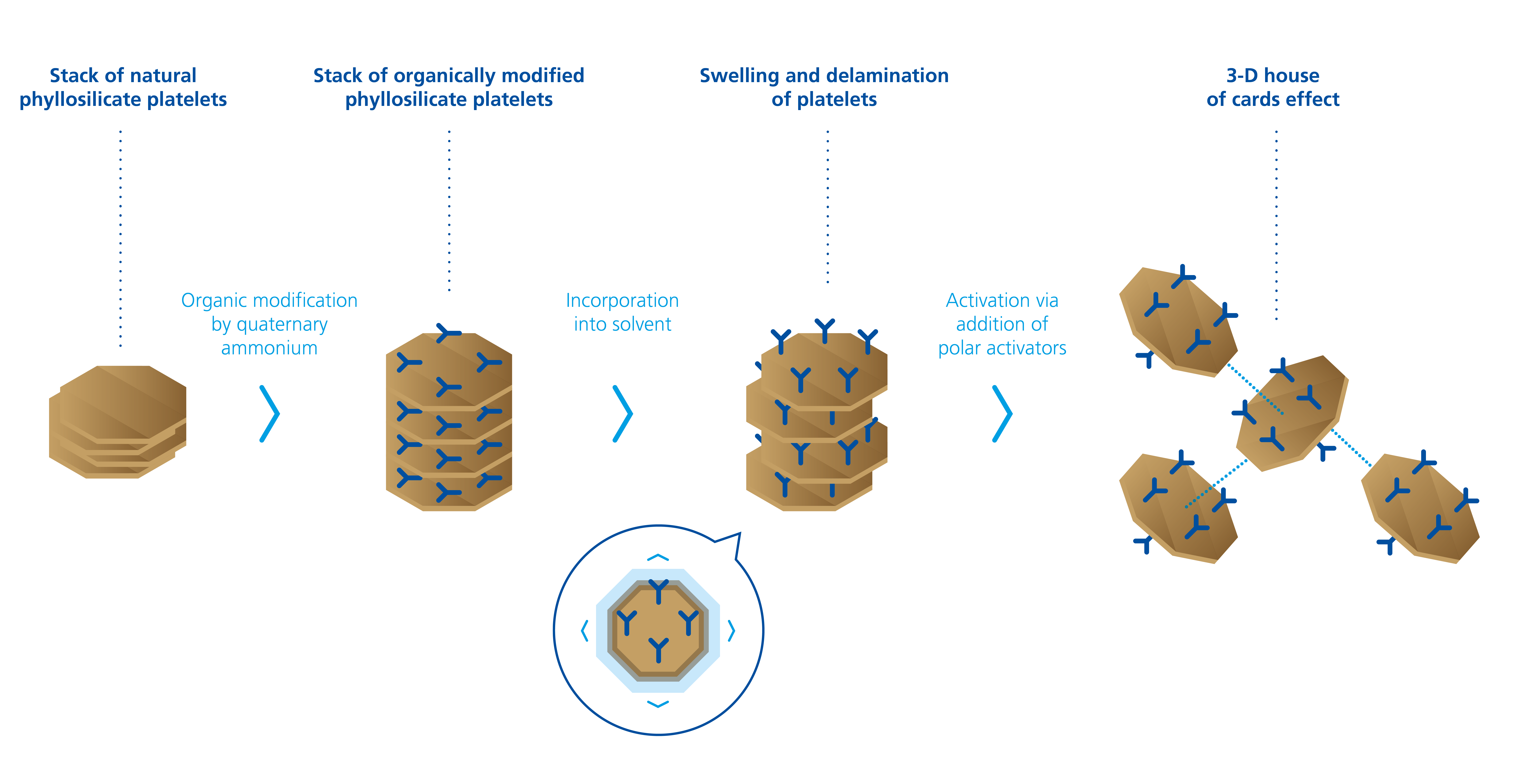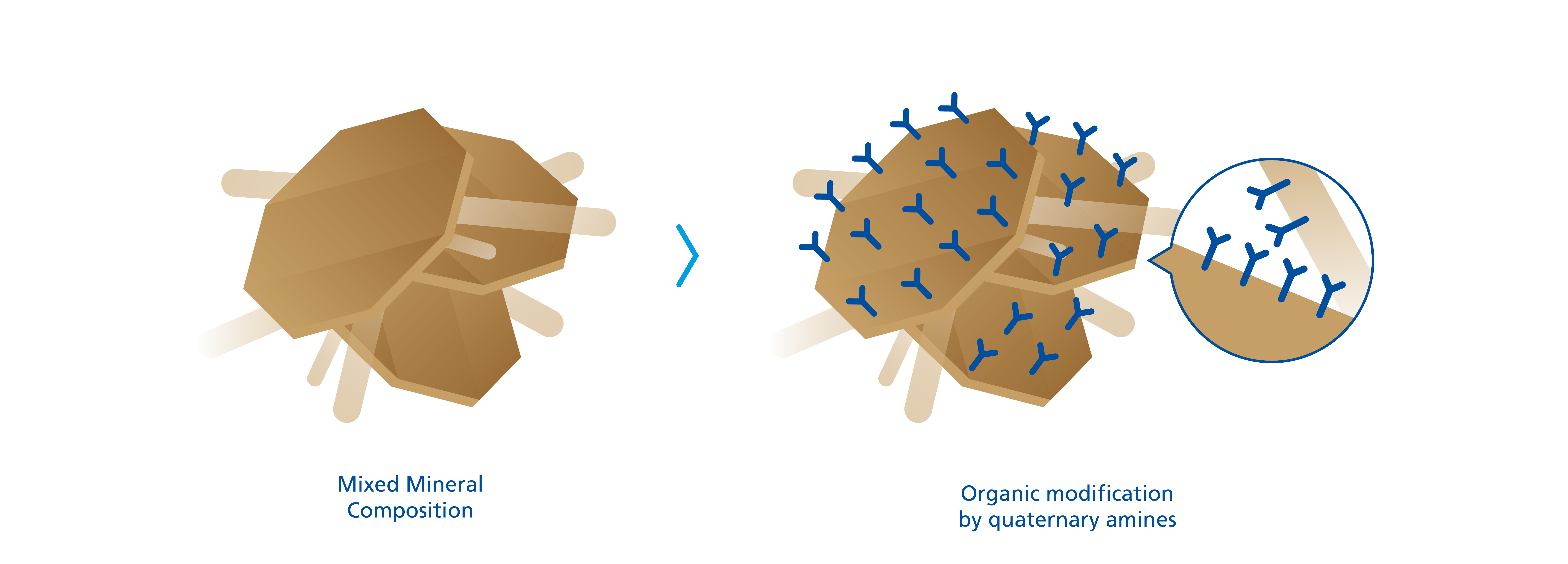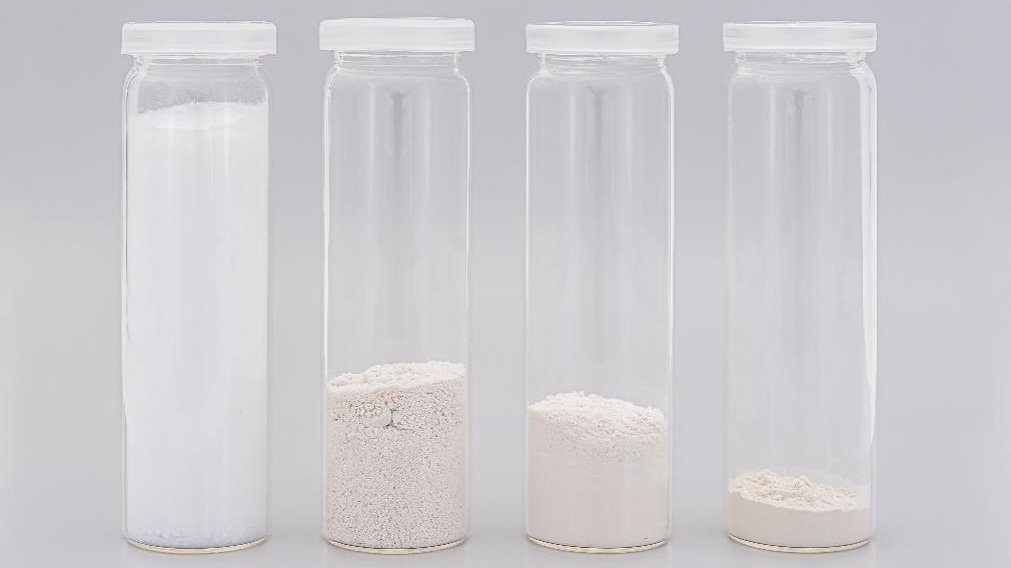
Phyllosilicates can be modified by suitable treatment to form organically modified phyllosilicates for use as rheology additives in non-aqueous applications. The 100 % powder products allow the use in solvent-borne and solvent-free systems and are characterized by their universal suitability in a wide range of polarities and a good price-performance ratio.
Due to their hydrophilic character, natural phyllosilicates are only suitable for use in aqueous systems. Modification with quaternary ammonium compounds of different polarity (from medium-polar to non-polar) also allows their use in solvent-borne systems. In addition to the influence of the polarity of the ammonium compound on the compatibility, its applied quantity plays a decisive role in the dispersibility and activation of the organically modified phyllosilicate. A distinction is made between conventional and self-activating grades, depending on the level of organic content.
Also in the case of organically modified phyllosilicates, the phyllosilicate platelets are present in agglomerated form (platelet stack) in the finished powder product. When the powder is incorporated into the formulation, the liquid components (e.g. solvents) penetrate between the platelets due to capillarity and cause swelling. At the same time, the platelets are separated from each other by the shear forces acting on them. The more similar the polarity of the solvent used is to the polarity of the quaternary ammonium salt used, the stronger the swelling behavior of the platelet stacks and the better the platelets can be delaminated. The higher the content of the organic modification, the easier it is to delaminate the platelets. However, the organic content cannot be increased to any extent, because the proportion of rheologically active phyllosilicate platelets is otherwise reduced, which has a negative effect on the rheological effectiveness. The best effectiveness is achieved with a maximum organic content of 25-30 % (based on the phyllosilicate), but complete particle delamination requires relatively high shear forces. The self-activating organically modified phyllosilicates contain up to 40 % organic content, but due to their lower content of phyllosilicate, they are also less rheologically effective.

The rheological effect of this additive group is based on the formation of a three-dimensional structure via hydrogen bonding between the individual phyllosilicate platelets (house of cards effect). For this purpose, it is necessary that sufficient OH groups are present in the formulation, which may also be achieved by adding polar activators (e.g. alcohol/water or propylene carbonate/water in a ratio of 95:5). A dosage of 30 % polar activator (calculated on the organophilic phyllosilicate content) has proven effective for standard products. For the self-activating organically modified phyllosilicates, it is generally not necessary to use an activator. Exceptions are formulations with very low-polar, purely aliphatic solvents.
The incorporation of the organically modified phyllosilicates is possible either as direct addition during the grinding process or via semi-finished products (e.g. 10 % paste in solvent). Semi-finished products can also be added for subsequent adjustment (post addition) of the viscosity.
The typical thixotropic flow behavior is most noticeable in low-filled systems and becomes increasingly pseudoplastic with higher filler loading. By using so-called rheological synergists, the effectiveness can be reinforced by additional hydrogen bonds.
The advantages of organically modified phyllosilicates outweigh possible limitations, which is why the products are very widely used in the market.
Mixed minerals are organically modified phyllosilicates with a special combination of platelet and rod-like particles. The heterogeneous mixture of different particles leads to application advantages compared to conventional organically modified phyllosilicates. Whereas in organically modified phyllosilicates the platelets lie flat on top of each other, in mixed minerals the platelets are separated from each other by rods, so that lower adhesion forces lead to easier delamination. In practice, this means much easier penetration of the solvent between the particles and thus noticeably faster swelling. In addition, dispersion is faster and can take place with lower shear forces. Furthermore, mixed minerals do not require an additional polar activator. The advantages of mixed minerals are primarily seen in the formulation of high-solids systems in which a high film thickness is to be achieved and the emphasis is not on high gloss retention (e.g. thick film coatings, heavy-duty corrosion protection and sealants and adhesives). Due to the combination of the different particle shapes, they exhibit a much more pseudoplastic flow behavior. In addition, mixed mineral pastes suitable for universal use can be produced with a significantly higher solids content.


Compared to fumed silica, mixed minerals offer further advantages in handling due to their significantly lower volume and the associated lower dust load.
As with the organically modified phyllosilicates, the representatives of the mixed minerals are also modified with different quaternary ammonium compounds in order to be suitable for the widest possible polarity range. The rheological effectiveness of the mixed minerals can also be reinforced by combining them with rheological synergists. The addition takes place after the dispersion of the mixed mineral into the finished system (post addition) and leads to a reinforcement of the existing structure.